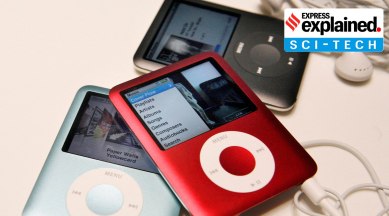Explained: Why Apple discontinued iPod, and what next for its music ecosystem
Apple is discontinuing its portable music player iPod. A look at why it was launched back in 2001, the journey is charted for the company, what led to its downfall, and what next for the company's music ecosystem.

After a run that lasted more than 20 years, Apple has pulled the plug on its portable music player iPod — a device that arguably revolutionised the music industry when it was launched in October 2001. Through its two-decade journey, the iPod came in various shapes and sizes starting with the pocket-sized iPod classic with a click wheel and the final iPod touch — which Apple said will be on sale till supplies last.
Why did Apple launch the iPod?
With the iPod, Apple initially had a goal to create a product that led people into buying more Macintosh computers. It was the first personal device launched by Apple outside of its Macintosh ecosystem, and the first step in the Cupertino, California-based company’s journey to releasing a host of personal communication devices over the years that would eventually catapult Apple into becoming the most valuable company in the world.
What journey did the iPod chart?
With an affordable handheld device that was available in different colours and models, the iPod became a product that introduced many people to the Apple ecosystem.
After the iPod classic — recognisable by its polished steel frame and the iconic click wheel — Apple launched the smaller iPod Mini, which was followed by an even smaller iPod Nano.
In 2005, Apple came out with the iPod shuffle — an entry-level device that used flash memory — and was the first iPod model without a screen.
In September 2007, just months after Apple unveiled the first iPhone, the company launched the iPod Touch — a multi-touch device that came with WiFi, Safari Browser, YouTube, etc. The model currently being sold is the seventh generation of iPod Touch.
While this was the iPod’s journey on the hardware side, on the music side, the device helped make music portable in a way that was significantly different than the portable cassette players in that era. The ability to buy and download songs for 99 cents and store them in a pocket-sized device was considered cutting-edge for its time.
What led to the device’s downfall?
In no small part, the device that was born in the aftermath of the iPod — the iPhone — played a role in the eventual discontinuation of portable music players. The increased functionalities on smartphones subjected the iPod to the diminishing utility principle.
In addition, the advent of fast, cheap internet, alongside music streaming services like Spotify, iTunes, Prime Music, etc meant substantially narrowing use for the iPod.
Since it was launched, Apple has sold an estimated 450 million iPod devices across models, but lately, sales have been sluggish.
Apple hasn’t separated iPod sales for years, but unit sales fell by about 24 per cent in fiscal 2014 compared with the previous fiscal year, WSJ reported. The company stopped reporting iPod sales in 2015.
According to The New York Times, which cited data from Loup Ventures, a venture capital firm specialising in tech research, Apple sold an estimated 3 million iPods last year, compared to the 250 million iPhones it sold.
What happens next to Apple’s music ecosystem?
The company will continue its music streaming services through Apple Music, which will be available on various other devices.
In a statement, Apple’s senior vice president of Worldwide Marketing Greg Joswiak said: “Today, the spirit of iPod lives on. We’ve integrated an incredible music experience across all of our products, from the iPhone to the Apple Watch to HomePod mini, and across Mac, iPad, and Apple TV”.
Newsletter | Click to get the day’s best explainers in your inbox